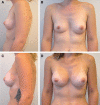Intentional Lower Pole Rotation of Anatomic Breast Implants in Chest Wall Deformities
- PMID: 29632783
- PMCID: PMC5889469
- DOI: 10.1097/GOX.0000000000001605
Intentional Lower Pole Rotation of Anatomic Breast Implants in Chest Wall Deformities
Abstract
Several methods have been described for the correction of congenital thoracic wall deformities. Our aim was to investigate the feasibility and clinical results of using standard anatomic breast implants with modified anatomic positioning according to the defect in congenital thoracic wall deformities. Between 2014 and 2015, 5 patients diagnosed with pectus excavatum (PE, n = 4) or pectus carinatum (PC, n = 1) and breast asymmetry or hypoplasia were evaluated. In all patients, a submammary incision and dual-plane subpectoral placement of texturized, anatomic implants were performed. In patients with PE, the lower pole of the implant was positioned medially to compensate for the caved chest. In patients with PC, the lower pole of the anatomic implant was positioned laterally to compensate for the prominent sternum. Outcome measures were satisfaction, minor and major complications, and morbidity. The mean surgery time was 95 ± 14 minutes, and the mean implant volume was 287 ± 56 cm3 (273 ± 60 cm3 on the right side and 305 ± 60 cm3 on the left side). After a median follow-up of 25 months (range: 2-35), all patients healed uneventfully, and a satisfactory correction of the thoracic wall deformity was achieved. Thus, by adjusting the lower pole of anatomic breast implants in a horizontal plane according to the thoracic defect, we showed satisfactory results. Our technique has a low complication rate and can be recommended for the correction of mild to moderate PE or PC.
Figures

References
-
- van Aalst JA, Phillips JD, Sadove AM. Pediatric chest wall and breast deformities. Plast Reconstr Surg. 2009;124(1 Suppl):38e–49e.. - PubMed
-
- Nuss D, Kelly RE, Jr, Croitoru DP, et al. A 10-year review of a minimally invasive technique for the correction of pectus excavatum. J Pediatr Surg. 1998;33:545–552.. - PubMed
-
- Stanford W, Bowers DG, Lindberg EF, et al. Silastic implants for correction of pectus excavatum. A new technique. Ann Thorac Surg. 1972;13:529–536.. - PubMed
-
- Saxena AK, Willital GH. Surgical repair of pectus carinatum. Int Surg. 1999;84:326–330.. - PubMed
LinkOut - more resources
Full Text Sources
Other Literature Sources
